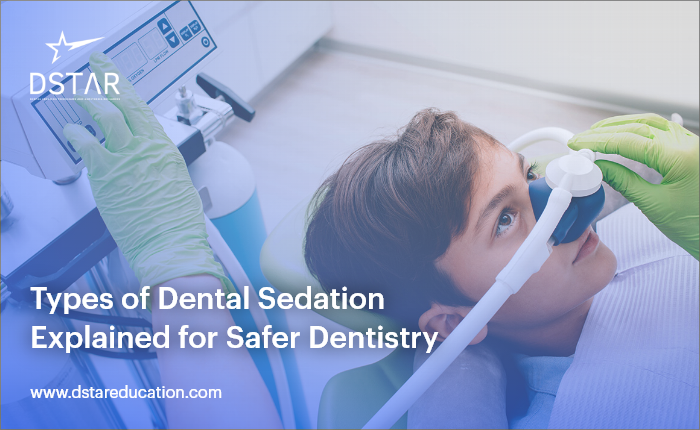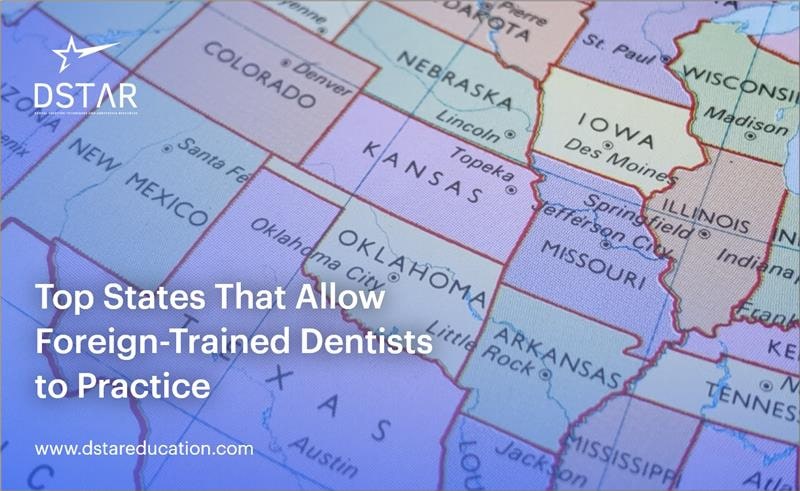Dental sedation has become an essential component of modern dentistry, enabling safe, pain-free procedures for patients who experience anxiety, have low pain thresholds, or require complex treatments. Understanding the different types of dental sedation and how they correspond to the various sedation levels ensures that practitioners provide care that aligns with patient needs and state permit regulations.
This guide clarifies the distinctions between minimal, moderate, and deep sedation, and general anesthesia, highlighting safety parameters, pharmacologic principles, and regulatory frameworks that govern sedation dentistry. It also differentiates between terms like conscious sedation vs moderate sedation and minimal vs moderate sedation, which are often misunderstood but critical for clinical compliance.
Understanding the Spectrum of Dental Sedation
Sedation in dentistry exists on a continuum ranging from minimal relaxation to complete unconsciousness. T The American Society of Anesthesiologists (ASA) and the American Dental Association (ADA) classify sedation levels based on how deeply they depress the patient’s consciousness and how much they impair protective airway reflexes and ventilatory function.
The four recognized types of sedation dentistry include:
- Minimal Sedation: The patient remains awake and responsive. This form of dental sedation primarily alleviates anxiety while maintaining normal cognitive and physical function.
- Moderate Sedation (Conscious Sedation): Patients respond purposefully to verbal commands or light tactile stimulation but may not remember much of the procedure.
- Deep Sedation: A controlled state where the patient cannot be easily aroused but can respond to repeated or painful stimulation.
- General Anesthesia: A drug-induced loss of consciousness where the patient is not arousable, even with painful stimuli. Ventilatory and cardiovascular support are typically necessary.
Each level corresponds to specific training, equipment, and regulatory mandates. Dentists providing sedation must hold appropriate permits and maintain CE hours consistent with sedation levels authorized under state law.
Minimal vs Moderate Sedation: The Foundational Distinction
When comparing minimal vs moderate sedation, the key difference lies in the depth of relaxation and airway safety.
- Under minimal sedation, patients can respond normally to verbal commands, maintain open airways independently, and exhibit stable cardiovascular function. Nitrous oxide inhalation or a single oral dose of benzodiazepine (like diazepam) typically achieves this state.
- In moderate sedation, patients exhibit a greater depression of consciousness but remain responsive to verbal cues. However, airway maintenance may require intervention.
Deep Sedation: The Threshold of Controlled Unresponsiveness
Deep sedation represents a higher level of central nervous system depression. Patients may lose protective reflexes, fail to maintain airway patency independently, and require assistance with maintaining airway patency. This type of dental sedation is used for longer, more invasive procedures or patients with significant anxiety who are unable to complete treatment with minimal or moderate sedation techniques.
Deep sedation differs from moderate sedation vs general anesthesia primarily in airway management requirements and the degree of cardiovascular stability. Unlike general anesthesia, patients under deep sedation can still respond to painful stimulation, although minimally.
Clinically, the most significant risk in deep sedation is airway obstruction. In an infant or small child airway, the risk is amplified because of anatomical features like a larger tongue relative to the oral cavity size, a higher laryngeal position, and a more anterior glottic opening. Practitioners must be trained to recognize and manage these risks before administering deep sedation to pediatric patients.
Pediatric Airway Considerations in Dental Sedation
Understanding pediatric airway anatomy is essential for safe sedation in children. The narrowest part of the pediatric airway lies at the cricoid cartilage (unlike adults, where it’s at the vocal cords), which makes airway management during pediatric vs adult airway anesthesia more delicate.
Sedating an infant or small child’s airway requires constant monitoring of oxygen saturation, capnography, and ventilation. Pediatric airways are softer, more flexible, and more prone to collapse under sedation. Even slight over-sedation can lead to hypoventilation or obstruction.
Dentists holding pediatric sedation permits must demonstrate proficiency in airway management and maintain PALS (Pediatric Advanced Life Support) certification. Many DSTAR Education courses emphasize this through live training sessions, simulation-based airway management, and scenario-specific CE modules designed to enhance patient safety in pediatric sedation settings.
Common Methods Across Types of Dental Sedation
Understanding how sedative agents are administered further clarifies the distinctions between types of sedation dentistry:
- Inhalation Sedation: Commonly referred to as nitrous oxide sedation or “laughing gas.” This is a minimal sedation technique that induces relaxation without loss of consciousness. Its rapid onset and reversibility make it one of the safest options in both adult and pediatric cases.
- Oral Sedation: Involves the administration of sedatives such as benzodiazepines. Depending on dosage and timing, this can achieve minimal or moderate sedation levels. Oral routes are widely used for their simplicity but require precise dosage control to prevent oversedation, particularly in children.
- Intravenous (IV) Sedation: Provides rapid control over sedation depth, making it appropriate for moderate or deep sedation. This route allows real-time adjustment but demands advanced monitoring and immediate access to airway management tools.
- General Anesthesia: Administered via inhalational or intravenous agents to induce total unconsciousness. Reserved for lengthy or surgical dental procedures, it requires full anesthesia permits and compliance with hospital-grade safety standards.
Selecting the right type of dental sedation depends on the procedure’s complexity, the patient’s medical history, and the provider’s certification and training. Dentists must never exceed their authorized sedation levels as defined by their permit type and training.
Safety Protocols and Clinical Oversight
Patient safety under any level of dental sedation depends on continuous physiological monitoring, trained personnel, and compliance with emergency readiness standards.
Key safety components include:
- Pre-Sedation Evaluation: Review of medical history, airway assessment, and ASA classification.
- Intraoperative Monitoring: Continuous pulse oximetry, EKG, blood pressure, and capnography.
- Post-Sedation Recovery: Documentation of consciousness level, airway patency, and discharge criteria.
In pediatric sedation, providers must account for anatomical differences that increase airway sensitivity rather than structural collapse. The narrowest part of the pediatric airway lies at the cricoid cartilage, which becomes relevant when placing airway devices or managing intubation.
An endotracheal tube that passes easily through the vocal cords may still fit tightly at this level, increasing the risk of mucosal injury or postoperative swelling if left in place for extended procedures. Practitioners must therefore use appropriately sized airway devices, maintain gentle ventilation, and monitor airway resistance or stridor during recovery.
Selecting the Safest Type of Dental Sedation
The safest type of dental sedation depends on patient-specific risk factors and provider training. For most healthy adults, minimal or moderate sedation (using nitrous oxide or oral benzodiazepines) provides sufficient comfort with minimal physiological disruption.
For anxious pediatric patients or those requiring more invasive procedures, deep sedation may be indicated, but only in settings equipped with emergency airway tools and qualified providers.
Ultimately, safety is achieved not just through drug choice but through rigorous compliance with monitoring standards, sedation permit regulations, and continuing education.
FAQs
1. What are the different types of sedation at the dentist?
There are four recognized types of dental sedation: minimal, moderate, deep, and general anesthesia, each offering progressively deeper levels of relaxation and requiring specific training and permits.
2. What may be the safest type of sedation method used in dentistry?
Inhalation sedation using nitrous oxide is considered the safest because of its rapid onset, adjustability, and minimal impact on airway or cardiovascular function.
3. What are the four levels of sedation?
The four levels of sedation are minimal, moderate, deep, and general anesthesia, as defined by the ADA and TSBDE guidelines.
4. Are there different types of sedation?
Yes. Types of sedation dentistry include inhalation, oral, intravenous (IV), and general anesthesia methods. Each corresponds to a specific sedation level and monitoring requirement.
5. What is four sedation?
“Level 4 sedation” refers to deep sedation or general anesthesia under the TSBDE permitting structure, requiring the highest level of training and facility readiness.
6. What is the most commonly used sedation?
Nitrous oxide inhalation is the most commonly used form of dental sedation, preferred for its safety, ease of titration, and quick recovery profile.
Conclusion
Mastering the types of dental sedation allows dental professionals to deliver safe, efficient, and patient-centered care. Whether managing a routine cleaning with minimal sedation or conducting oral surgery under deep sedation, maintaining compliance with training standards and permit levels is essential.
For Texas practitioners, DSTAR Education remains a trusted provider of sedation training, CE renewal, and airway management courses tailored to meet TSBDE and ADA requirements. A clear understanding of sedation levels and when to apply each ensures both patient safety and regulatory compliance across all practice settings.
 Take Free TSBDE Anesthesia Jurisprudence Practice Exam Now!
Take Free TSBDE Anesthesia Jurisprudence Practice Exam Now!












